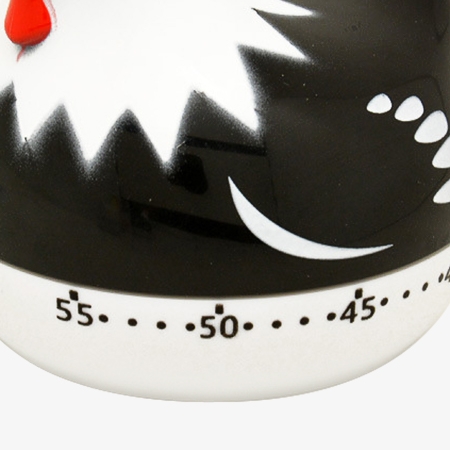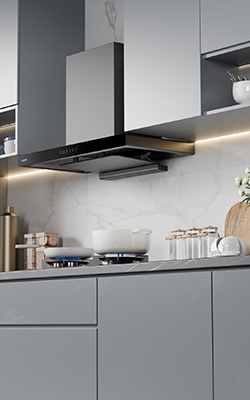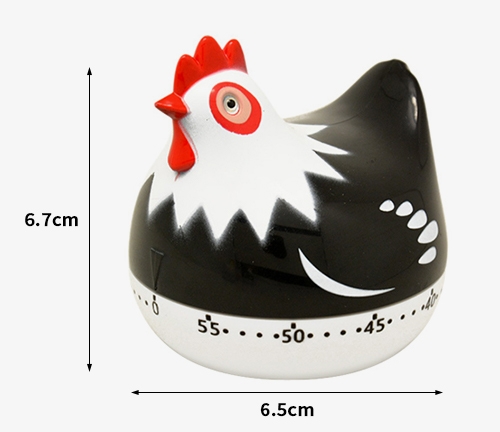A chicken shaped kitchen timer is a functional cooking tool designed to look like a chicken, typically made of ABS plastic. Its playful design adds charm to kitchens while helping cooks manage baking, boiling, or roasting times. Chicken timer requires no batteries, making it reliable and easy to use.

Clear Scale on a Mechanical Chicken Kitchen Timer
- The most important advantage of a clear scale is the accuracy it provides when setting the mechanical timer. Cooking and baking often require precise timing to ensure optimal results. A clearly marked scale with legible numbers and tick marks helps users set the desired time more accurately.
- A food timer with a clear scale is much easier to use, especially for individuals with visual impairments, larger, bold numbers and distinct minute markings reduce confusion and frustration.

Chicken Kitchen Timer With Small and Compact Size
- One of the most notable advantages of a small and compact kitchen cooking timer is that it takes up minimal space. A compact timer can be easily placed on a countertop, shelf, or even in a drawer without contributing to clutter.
- A lightweight and small timer is easy to move around. Whether you are cooking in different areas of the kitchen or taking it along to an outdoor cookout, the portability makes it a practical choice.
- The whimsical design of a chicken shaped kitchen timer adds a touch of charm and personality to any kitchen. Despite its small size, it stands out as a decorative piece.
Applications
SISCO mechanical kitchen timers have a wide range of application fields beyond simply timing cooking tasks. Primarily used in home and professional kitchens to track cooking and baking durations, cooking timers help prevent overcooking and ensure food safety. In education, they support time management during classroom activities or timed tests. In healthcare, they assist with medication reminders and therapy sessions. Fitness enthusiasts use them for interval training or workout sets.

Laboratory

Study

Yoga

Cooking
| Model | SISCO-KT-RB219 |
| Material | ABS |
| Color | white+black/ white+yellow |
| Timer range | 60 mintues |
| Dimension | 6.5*6.7cm |
| Alarm time | about 3~4s |
| Net weight | 100g |
Dimension:

Q1: Can I use a kitchen timer for activities other than cooking?
A1: Yes, a kitchen cooking timer can be used for a variety of activities beyond cooking. It's a great tool for time management, helping you stay focused on tasks and avoid distractions. It's also helpful for exercise routines, like setting intervals for high-intensity workouts or yoga poses.
Q2: What should I consider when buying a kitchen timer?
A2: First, look for ease of use. A simple, intuitive interface with clear buttons is essential, especially when you're busy cooking. Consider the display: large, easy-to-read digits are crucial, particularly if you're working in a busy or have limited space. Durability is another factor; choose a timer made from sturdy materials that can withstand kitchen conditions. Waterproof or splash-resistant models are ideal for high-moisture environments. Portability is also important if you move it between kitchen stations.
Q3: Is it better to use a mechanical or digital kitchen timer?
A3: The choice between a mechanical or digital kitchen timer depends on personal preference and the specific needs of the user. Mechanical kitchen timers are often favored for their simplicity and durability. They don't require batteries and can last a long time with minimal maintenance. Their analog nature is also appreciated by those who prefer a more hands-on, traditional experience in the kitchen. On the other hand, digital kitchen timers offer precision and convenience. They typically provide more accurate timekeeping, with some allowing you to set multiple timers at once. Digital timers are usually more versatile, with additional features like countdown memory, stopwatches, and larger displays for easier reading.
Tips: How should a mechanical timer be stored when not in use?
To properly store a mechanical timer when not in use, ensure it's kept in a cool, dry place to prevent moisture and heat from damaging the internal components. Avoid direct sunlight, which can cause materials to degrade over time. Store it upright to avoid any pressure on the mechanism, and if possible, place it in a dust-free container to protect it from dirt. Lastly, avoid placing heavy objects on top of the timer to preserve its integrity.
Thank you for buying industrial test and measurement equipment on SISCO.com, all products sold by SISCO and the partner cover a 12 months warranty, effective from the date of receiving the products.
What is covered?
SISCO is responsible for providing free spare parts, and free technical support to assist the customer to repair the defective products until the problem is solved.
What is not covered?
- Product purchased from anyone other than a SISCO store or a SISCO authorized reseller.
- Expendable parts.
- Routine cleaning or normal cosmetic and mechanical wear.
- Damage from misuse, abuse or neglect.
- Damage from use of parts other than SISCO approved.
- Damage from use outside the product’s usage or storage parameters.
- Damage from use of parts not sold by SISCO.
- Damage from modification or incorporation into other products.
- Damage from repair or replacement of warranted parts by a service provider other than a SISCO authorized service provider.
- Damage caused by the application environment not meeting the product usage requirements and the failure to perform preventive maintenance.

